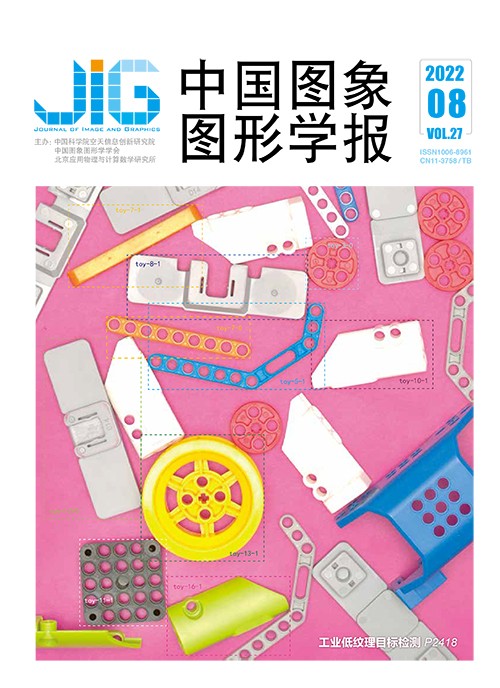
虚拟现实图像客观质量评价研究进展
周玉1,2, 汪一3,1, 李雷达4, 高陈强5, 卢兆林1,2(1.中国矿业大学信息与控制工程学院, 徐州 221116;2.徐州市第一人民医院, 徐州 221116;3.江苏师范大学科文学院, 徐州 221132;4.西安电子科技大学人工智能学院, 西安 710071;5.重庆邮电大学通信与信息工程学院, 重庆 400065) 摘 要
随着科学技术的发展,虚拟现实(virtual reality,VR)技术逐渐渗透到医疗、教育、军事和娱乐等众多领域,并凭借在各个领域广阔的应用前景而受到广泛关注。鉴于视觉质量是决定VR技术能否成功应用的关键,且图像是VR应用最基础和最重要的视觉信息载体,VR图像质量评价已经成为质量评价领域的重要前沿性研究方向。与传统图像质量评价类似,VR图像质量评价可以分为主观质量评价和客观质量评价。由于客观质量评价相比主观质量评价具有成本低、稳定性高和应用范围广等优点,对VR图像客观质量评价的研究受到了国内外学者的高度重视。目前,关于VR图像客观质量评价的研究已经取得了一定进展,但是文献中缺少对该方向相关研究方法的综述。基于此,本文针对VR图像客观质量评价的研究进行概述。首先,对VR图像质量评价的研究现状进行分析。然后,重点对现有的VR图像客观质量评价模型进行综述。具体地,根据模型是否需要使用原始无失真图像信息作为参考,将现有的VR图像客观质量评价模型划分为全参考型和无参考型两大类。其中,全参考型方法进一步划分为基于峰值信噪比/结构相似度的方法和基于传统机器学习的方法。根据特征表达空间的不同,无参考型VR图像质量评价模型划分为3类:基于等矩形投影表达空间的方法、基于其他投影表达空间的方法和基于实际观看空间的方法。介绍完各类模型后,分别对其相应的优缺点进行分析。此外,本文对VR图像客观质量评价模型的性能评价指标和现有VR图像质量评价数据库进行了归纳。最后对VR图像客观质量评价模型的应用进行了介绍,并指出了未来的研究可能的发展方向。
关键词
Research progress in objective quality evaluation of virtual reality images
Zhou Yu1,2, Wang Yi3,1, Li Leida4, Gao Chenqiang5, Lu Zhaolin1,2(1.School of Information and Control Engineering, China University of Mining and Technology, Xuzhou 221116, China;2.Xuzhou First Peoples Hospital, Xuzhou 221116, China;3.Jiangsu Normal University Kewen College, Xuzhou 221132, China;4.School of Artificial Intelligence, Xidian University, Xi'an 710071, China;5.School of Communication and Information Engineering, Chongqing University of Posts and Telecommunications, Chongqing 400065, China) Abstract
Virtual reality (VR) technology has gradually penetrated into many fields such as medical education, military and entertainment. Given visual quality is the key to the successful application of VR technology, and the image is visual information benched carrier of VR applications, VR image quality evaluation has become an important frontier research direction for quality evaluation. Just like traditional image quality evaluation, VR image quality evaluation can be divided into subjective quality evaluation and objective quality evaluation. Among them, the subjective quality evaluation methods refer to images scoring through human eyes followed by some data processing steps to obtain the subjective scores, while the objective quality evaluation methods focus on the methods of images scoring based on designing the mathematical model using computers to simulate the subjective scoring results as closely as possible. Compared to the subjective quality evaluation, the objective quality evaluation has its priorities s of lower cost, stronger stability and wider application scope. Many researchers in the scientific research institutions and colleges have dedicated to studying the objective quality evaluation of VR images. Our executive summary is focused on the research of objective quality evaluation of VR images. First, the current situation of VR image quality evaluation is summarized. Then, the existing objective quality evaluation models of VR images are mainly introduced and analyzed. According to whether the models need to use the original undistorted image information as modeling reference, current objective quality evaluation models for VR images are divided into two types, including the full-reference (FR) and no-reference (NR) types. The ground truth based FR models need the completed original image information as reference, while the NR models can achieve quality evaluation of a distorted VR image without any reference information. Specifically, the FR models can be divided into two categories for VR images, including the peak-signal-to-noise ratio/structural similarity (PSNR/SSIM) based methods and the machine learning based methods. The latter first extract features from VR images and then train the quality evaluation model via the support vector regression method or the random forest method. The NR models are further divided into three categories:the equirectangular projection (ERP) expression space based methods, the other projection expression spaces based methods and the actual viewing space based methods. These models are classified according to the space in which features are extracted. For the first kind of models, the raw spherical VR image is first transferred to the ERP space for feature expression, while it is converted to other projection spaces or the actual viewing space for the other two kinds of methods. The reason why the ERP expression space based methods are listed as a separate category is that the ERP space is the default and the mostly used projection space. Followed the space transformation, there are also two options for the sequential quality evaluation consisting of the traditional quality evaluation methods and the deep-learning based methods. For the traditional ones, the manual features are first extracted and fused to generate the final quality score or fed into the model trainer to obtain the quality assessment model. For the deep-learning based methods, both the feature extraction and quality prediction steps are conducted based on deep neural networks. The pros and cons of them are further analyzed. In addition, the performance evaluation indexes of the objective quality evaluation models of VR images are introduced, which are consistent to other image quality evaluations. The detailed existing VR image databases are summarized subsequently. Finally, our review focuses on the applications of VR image objective quality evaluation models and predicts the future potentials further.
Keywords
image quality evaluation objective evaluation virtual reality (VR) spherical image equirectangular projection (ERP)
|



 中国图象图形学报 │ 京ICP备05080539号-4 │ 本系统由
中国图象图形学报 │ 京ICP备05080539号-4 │ 本系统由